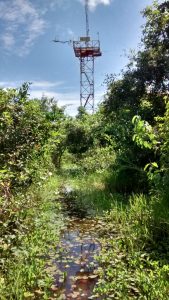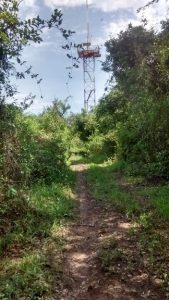BR-Npw: Northern Pantanal Wetland
- Overview
- Windroses
- Data Citation
- Data Use Log
- Image Gallery
- Remote Sensing Data
- MODIS
- PhenoCam
- GeoNEX
- Publications
- BADM
| Tower_team: | |
| PI: | Higo Dalmagro higojdalmagro@gmail.com - Universidade de Cuiabá |
| PI: | Mark Johnson mark.johnson@ubc.ca - University of British Columbia |
| AncContact: | George Vourlitis georgev@csusm.edu - Universidade Estadual da Califórnia, San Marcos |
| AncContact: | Paulo Arruda paulo.zanella@gmail.com - Universidade Federal de Mato Grosso |
| Lat, Long: | -16.4980, -56.4120 |
| Elevation(m): | 120 |
| Network Affiliations: | AmeriFlux |
| Vegetation IGBP: | WSA (Woody Savannas: Lands with herbaceous and other understory systems, and with forest canopy cover between 30-60%. The forest cover height exceeds 2 meters.) |
| Climate Koeppen: | Aw (Tropical savanna) |
| Mean Annual Temp (°C): | 24.9 |
| Mean Annual Precip. (mm): | 1486 |
| Flux Species Measured: | CO2, CH4, H, H2O |
| Years Data Collected: | 2013 - Present |
| Years Data Available: | AmeriFlux BASE 2013 - 2017 Data Citation AmeriFlux FLUXNET 2013 - 2017 Data Citation |
| Data Use Policy: | AmeriFlux CC-BY-4.0 Policy1 |
| Description: | The site is located in the northern Pantanal in central South America. The site is subject to seasonal flooding with distinct wet seasons (November to ... The site is located in the northern Pantanal in central South America. The site is subject to seasonal flooding with distinct wet seasons (November to April) and dry seasons (May to October). See MoreShow Less |
| URL: | — |
| Research Topics: | Carbon fluxes, wetland processes |
| Acknowledgment: | Brazilian National Institute for Science and Technology in Wetlands (INCT-INAU), Federal University of Mato Grosso (UFMT - PGFA and PGAT), University of Cuiabá (UNIC) and SESC-Pantanal. |
- This site’s data can also be used under the more restrictive AmeriFlux Legacy Policy.
The AmeriFlux Legacy Policy must be followed if this site’s data are combined with data from sites that require the AmeriFlux Legacy Policy.




Copyright preference: As long as credit is given
BR-Npw: Northern Pantanal Wetland
- Overview
- Windroses
- Data Citation
- Data Use Log
- Image Gallery
- Remote Sensing Data
- MODIS
- PhenoCam
- GeoNEX
- Publications
- BADM
Use the information below for citation of this site. See the Data Policy page for more details.
DOI(s) for citing BR-Npw data
Data Use Policy: AmeriFlux CC-BY-4.0 License
This site’s data can also be used under the more restrictive AmeriFlux Legacy Policy.
The AmeriFlux Legacy Policy must be followed if BR-Npw data are combined with data from sites that require the AmeriFlux Legacy Policy.
- AmeriFlux BASE: https://doi.org/10.17190/AMF/1579716
Citation: George Vourlitis, Higo Dalmagro, José de S. Nogueira, Mark Johnson, Paulo Arruda (2019), AmeriFlux BASE BR-Npw Northern Pantanal Wetland, Ver. 1-5, AmeriFlux AMP, (Dataset). https://doi.org/10.17190/AMF/1579716 - AmeriFlux FLUXNET: https://doi.org/10.17190/AMF/1881563
Citation: George Vourlitis, Higo Dalmagro, José de S. Nogueira, Mark Johnson, Paulo Arruda (2025), AmeriFlux FLUXNET-1F BR-Npw Northern Pantanal Wetland, Ver. 5-7, AmeriFlux AMP, (Dataset). https://doi.org/10.17190/AMF/1881563
Find global FLUXNET datasets, like FLUXNET2015 and FLUXNET-CH4, and their citation information at fluxnet.org.
To cite BADM when downloaded on their own, use the publications below for citing site characterization. When using BADM that are downloaded with AmeriFlux BASE and AmeriFlux FLUXNET products, use the DOI citation for the associated data product.
Publication(s) for citing site characterization
- —
Acknowledgments
- —
Resources
- AmeriFlux Logos & Acknowledgments
BR-Npw: Northern Pantanal Wetland
- Overview
- Windroses
- Data Citation
- Data Use Log
- Image Gallery
- Remote Sensing Data
- MODIS
- PhenoCam
- GeoNEX
- Publications
- BADM

This page displays the list of downloads of data for the site BR-Npw.
Note: Results are the number of downloads to distinct data users. The Download Count column indicates the number of times the data user downloaded the data. The Version column refers to the version of the data product for the site that was downloaded by the data user.
| Date | Name | Data Product | Version | Intended Use | Intended Use Description | Download Count |
|---|
| Date | Name | Data Product | Vers. | Intended Use | Intended Use Description | Download Count |
|---|---|---|---|---|---|---|
Showing 0 to 0 of 0 results
Not Found
Uh Oh. Something is missing. Try double checking the URL and try again.
BR-Npw: Northern Pantanal Wetland
- Overview
- Windroses
- Data Citation
- Data Use Log
- Image Gallery
- Remote Sensing Data
- MODIS
- PhenoCam
- GeoNEX
- Publications
- BADM
| AmeriFlux Images | Add Image |
 BR-Npw
BR-Npw Tower
Tower during the flood season
Keywords: —
Location: Brazil
View in Original Size
To download, right-click photo (Mac: control-click) and choose Save Image As
 BR-Npw
BR-Npw Tower
Tower during the dry season
Keywords: —
Location: Brazil
View in Original Size
To download, right-click photo (Mac: control-click) and choose Save Image As
 BR-Npw
BR-Npw Storm
I think it's going to rain.
Keywords: Pantanal
Location: Brazil
View in Original Size
To download, right-click photo (Mac: control-click) and choose Save Image As
BR-Npw: Northern Pantanal Wetland
- Overview
- Windroses
- Data Citation
- Data Use Log
- Image Gallery
- Remote Sensing Data
- MODIS
- PhenoCam
- GeoNEX
- Publications
- BADM
MODIS NDVI
The time series shows the 16-day Normalized Difference Vegetation Index (NDVI) average from the MOD13Q1 data product.
Use the slider below the time series to zoom in and out.
To view / download these data and other MOD13Q1 products for this site, visit MODIS/Terra Vegetation Indices.
For other related products, visit MODIS/VIIRS Fixed Sites Subsets Tool.
Citation:
ORNL DAAC. 2018. Terrestrial Ecology Subsetting & Visualization Services (TESViS) Fixed Sites Subsets. ORNL DAAC, Oak Ridge, Tennessee, USA. https://doi.org/10.3334/ORNLDAAC/1567
MODIS NDVI subsetted data is not yet available for this site.
For a complete list of AmeriFlux sites, visit ORNL DAAC's MODIS/VIIRS Fixed Sites Subsets Tool.
PhenoCam Images and Derived Time Series Data
PhenoCams are high-resolution digital cameras that take repeated images of studied ecosystems and provide quantitative information about the canopy phenology. The PhenoCam Network coordinates the camera installation and data reporting/analyses across sites in the Americas, providing automated, near-surface remote sensing of canopy phenology across a range of ecosystems and climate zones. Use of PhenoCam images / data should follow the PhenoCam Data Use Policy .
No PhenoCam data for this siteGeoNEX Data Products
GeoNEX led by NASA Earth eXchange (NEX) is a collaborative effort for generating Earth monitoring products from the new generation of geostationary satellite sensors. GeoNEX has produced a suite of geostationary data products including surface reflectance, land surface temperature, surface solar radiation, and many others.
The GeoNEX Common Grid locates GeoNEX data in the geographic (latitude/longitude) projection. Pixels (grid cells) are created at regular 0.005°, 0.01°, and 0.02° resolutions.
GeoNEX pixels below cover the area 0.06° x 0.06° around and including site BR-Npw, -16.498, -56.412.
Click a square in the grid at left to display its data below.
Coordinates for selected GeoNEX Pixel
Graph controls:
- Zoom: click-drag
- Pan: shift-click-drag
- Restore zoom level: double-click
- Use the slider below the time series to zoom in and out.
All download requests will be logged.
NDVI: Normalized Difference Vegetation Index
Resolution: 0.01° x 0.01° & 10 minutes
Coordinates for pixel:
NIRv Near-Infrared Reflectance of vegetation
Resolution: 0.01° x 0.01° & 10 minutes
Coordinates for pixel:
DSR: Surface downward shortwave radiation
Resolution: 0.01° x 0.01° & Hourly
Coordinates for pixel:
LST: Land Surface Temperature
Resolution: 0.02° x 0.02° & Hourly
Coordinates for pixel:
Citation
This material can be used without obtaining permission from NASA. NASA should be acknowledged as the source of this material.
Subset Data Citation:
- Hashimoto, H., Wang, W., Park, T., Khajehei, S., Ichii, K., Michaelis, A.R., Guzman, A., Nemani, R.R., Torn, M., Yi, K., Brosnan, I.G. (in preparation). Subsets of geostationary satellite data over international observing network sites for studying the diurnal dynamics of energy, carbon, and water cycles.
Relevant Science Publication Citation:
GeoNEX Surface Reflectance for Vegetation Indices (NDVI & NIRv)- Wang, W., Wang, Y., Lyapustin, A., Hashimoto, H., Park, T., Michaelis, A., & Nemani, R. (2022). A novel atmospheric correction algorithm to exploit the diurnal variability in hypertemporal geostationary observations. Remote Sensing, 14(4), 964.
- Li, R., Wang, D., Wang, W., & Nemani, R. (2023). A GeoNEX-based high-spatiotemporal-resolution product of land surface downward shortwave radiation and photosynthetically active radiation. Earth System Science Data, 15(3), 1419-1436.
- Jia, A., Liang, S., & Wang, D. (2022). Generating a 2-km, all-sky, hourly land surface temperature product from Advanced Baseline Imager data. Remote Sensing of Environment, 278, 113105.
BR-Npw: Northern Pantanal Wetland
- Overview
- Windroses
- Data Citation
- Data Use Log
- Image Gallery
- Remote Sensing Data
- MODIS
- PhenoCam
- GeoNEX
- Publications
- BADM
| AmeriFlux Publications | Add Publication |
| Year | Publication |
|---|---|
| 2019 | Dalmagro, H. J., Zanella de Arruda, P. H., Vourlitis, G. L., Lathuillière, M. J., de S. Nogueira, J., Couto, E. G., Johnson, M. S. (2019) Radiative Forcing Of Methane Fluxes Offsets Net Carbon Dioxide Uptake For A Tropical Flooded Forest, Global Change Biology, 25(6), 1967-1981. https://doi.org/10.1111/gcb.14615 |
| 2019 | Kim, Y., Johnson, M. S., Knox, S. H., Black, T. A., Dalmagro, H. J., Kang, M., Kim, J., Baldocchi, D. (2019) Gap‐Filling Approaches For Eddy Covariance Methane Fluxes: A Comparison Of Three Machine Learning Algorithms And A Traditional Method With Principal Component Analysis, Global Change Biology, . https://doi.org/10.1111/gcb.14845 |
BR-Npw: Northern Pantanal Wetland
- Overview
- Windroses
- Data Citation
- Data Use Log
- Image Gallery
- Remote Sensing Data
- MODIS
- PhenoCam
- GeoNEX
- Publications
- BADM
BADM for This Site
Access the Biological, Ancillary, Disturbance and Metadata (BADM) information and data for this site.
BADM contain information for many uses, such as characterizing a site’s vegetation and soil, describing disturbance history, and defining instrumentation for flux processing. They complement the flux/met data.
- Download BADM for this site*
- View Site General Info for this site (Overview tab)*
- Use Online Editor to update Site General Info or DOI Authorship
- Update information about submitted data (Variable Information tool)
- More BADM resources
* Online updates are shown on the Overview tab real time. However, downloaded BADM files will not reflect those updates until they have been reviewed for QA/QC.
BR-Npw: Northern Pantanal Wetland
- Overview
- Windroses
- Data Citation
- Data Use Log
- Image Gallery
- Remote Sensing Data
- MODIS
- PhenoCam
- GeoNEX
- Publications
- BADM
Wind Roses
Wind Speed (m/s)
Navigation
- Wind Speed Scale: Per Site
- Wind Direction Scale (%): Per Site
- Wind Speed Scale: Non-Linear
- Wind Direction Scale (%): AmeriFlux
